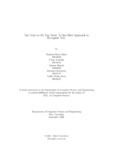| dc.contributor.advisor | Chakrabarty, Amitabha | |
| dc.contributor.author | Dipto, Shahriar Rumi | |
| dc.contributor.author | Nowshin, Priata | |
| dc.contributor.author | Ahmed, Intesur | |
| dc.contributor.author | Chowdhury, Deboraj | |
| dc.contributor.author | Noor, Galib Abdun | |
| dc.date.accessioned | 2022-01-12T06:16:19Z | |
| dc.date.available | 2022-01-12T06:16:19Z | |
| dc.date.copyright | 2021 | |
| dc.date.issued | 2021-09 | |
| dc.identifier.other | ID 20141036 | |
| dc.identifier.other | ID 20141035 | |
| dc.identifier.other | ID 18101685 | |
| dc.identifier.other | ID 18101242 | |
| dc.identifier.other | ID 20141037 | |
| dc.identifier.uri | http://hdl.handle.net/10361/15871 | |
| dc.description | This thesis is submitted in partial fulfillment of the requirements for the degree of Bachelor of Science in Computer Science and Engineering, 2021. | en_US |
| dc.description | Cataloged from PDF version of thesis. | |
| dc.description | Includes bibliographical references (pages 43-49). | |
| dc.description.abstract | Human knowledge can quickly learn any unfamiliar concepts based on what they
have previously learned. Keeping this in mind, researchers tested training models
with limited training data in machine learning classification functions.One-shot
learning has proven to be effective in the researches of Computer Vision sector, as
it works accurately with a single labeled training example and a small number of
training sets. By using a single input example from each class, one-shot learning can
work more efficiently and quickly. For training the architecture of neural networks
to predict similarities between two inputs, one-shot learning employs the Siamese
network as neural network architecture. This architecture has been successfully
used for various audio-related problems, but its use of one-shot learning in speaker
recognition has received less attention. The goal of this thesis is to apply the concept
of one-shot learning to classify speakers by extracting specific features, where it
uses triplet loss to train the model to learn through Siamese network and calculates
the rate of similarity while testing via support set and a query set to recognize the
speaker accurately and faster. The proposed system is trained on the LibriSpeech
dataset, which contains different audio recordings of speakers. The final one-shot is
performed on few previously unseen classes, utilizing only a single sample of each
type while making the classification by extracting features from training data and
calculating the similarity ratio to recognize the speaker through the proposed model
trained by the Siamese network. As we tested for several classes, the accuracy varied:
for two classes, we got 100%, for three classes 95%, for four classes 84%, and for
five classes 74%, which is significantly better than the other algorithms we tested
for our solution. The results suggest that Siamese networks are a viable solution to
the challenging one-shot audio classification issue. | en_US |
| dc.description.statementofresponsibility | Shahriar Rumi Dipto | |
| dc.description.statementofresponsibility | Priata Nowshin | |
| dc.description.statementofresponsibility | Intesur Ahmed | |
| dc.description.statementofresponsibility | Deboraj Chowdhury | |
| dc.description.statementofresponsibility | Galib Abdun Noor | |
| dc.format.extent | 49 pages | |
| dc.language.iso | en | en_US |
| dc.publisher | Brac University | en_US |
| dc.rights | Brac University theses are protected by copyright. They may be viewed from this source for any purpose, but reproduction or distribution in any format is prohibited without written permission. | |
| dc.subject | Audio classification | en_US |
| dc.subject | Siamese neural network | en_US |
| dc.subject | speaker recognition | en_US |
| dc.subject | Oneshot learning | en_US |
| dc.subject | Triplet loss | en_US |
| dc.subject.lcsh | Multimedia systems | |
| dc.subject.lcsh | Neural networks (Computer science) | |
| dc.title | One voice is all you need: a one-shot approach to recognize you | en_US |
| dc.type | Thesis | en_US |
| dc.contributor.department | Department of Computer Science and Engineering, Brac University | |
| dc.description.degree | B. Computer Science | |

